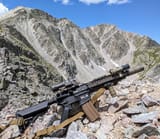Search Results
!!0nG8B4EyHDR/k/63991703#63995478
7/17/2025, 5:15:32 PM
>>63995428
The hammer can't start falling until the reciprocating assembly starts moving forward. This happens after the inelastic collision between the reciprocating assembly and the rear of the receiver extension buffer tube occurs. During this inelastic collision, the kinetic energy and momentum of the reciprocating assembly is not conserved, and so the speed and mass of the reciprocating assembly before the collision does not contribute to the forward motion in a well defined/understood way. In the extreme case where it is totally inelastic, say pretend that the reciprocating assembly is held fixed at the rearward position for some finite amount of time, nothing about the rearward motion contributes to or informs the forward motion. The position vs. time of the forward motion of the reciprocating assembly is set only by the spring constant, the spring potential energy stored (this we assume is fixed because the compression distance is independent of how fast said compression occurs, since in all cases we have this inelastic collision), and the reciprocating mass. The hammer fall speed (I think this is essentially the lock time?) is fixed by the hammer spring strength and the moment of inertia of the hammer assembly, and I guess the angular displacement the hammer has to travel to hit the firing pin, and so the race is just between the fixed lock time, and the forward motion of the reciprocating assembly, which like I'm positing is just a function of buffer weight and spring power.
Less buffer weight and a stronger spring should speed up the forward motion of the reciprocating assembly, helping it to outpace and "beat" the hammer. This is why I've always been confused that heavier buffers reduce the tendency for hammer follow light primer strikes.
I don't get it, really.
The hammer can't start falling until the reciprocating assembly starts moving forward. This happens after the inelastic collision between the reciprocating assembly and the rear of the receiver extension buffer tube occurs. During this inelastic collision, the kinetic energy and momentum of the reciprocating assembly is not conserved, and so the speed and mass of the reciprocating assembly before the collision does not contribute to the forward motion in a well defined/understood way. In the extreme case where it is totally inelastic, say pretend that the reciprocating assembly is held fixed at the rearward position for some finite amount of time, nothing about the rearward motion contributes to or informs the forward motion. The position vs. time of the forward motion of the reciprocating assembly is set only by the spring constant, the spring potential energy stored (this we assume is fixed because the compression distance is independent of how fast said compression occurs, since in all cases we have this inelastic collision), and the reciprocating mass. The hammer fall speed (I think this is essentially the lock time?) is fixed by the hammer spring strength and the moment of inertia of the hammer assembly, and I guess the angular displacement the hammer has to travel to hit the firing pin, and so the race is just between the fixed lock time, and the forward motion of the reciprocating assembly, which like I'm positing is just a function of buffer weight and spring power.
Less buffer weight and a stronger spring should speed up the forward motion of the reciprocating assembly, helping it to outpace and "beat" the hammer. This is why I've always been confused that heavier buffers reduce the tendency for hammer follow light primer strikes.
I don't get it, really.
Page 1
